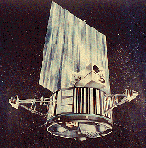The OSO-8 Archive The OSO-8 archive includes High level products, such as lightcurve files in FITS format and their plots in GIF format, and the raw data, which have been reformatted into FITS. The data are all from the Goddard Cosmic X-Ray Spectroscopy Experiment (GCXSE). There was a funded ADP proposal to restore the HEXCE data (PI Kemper). However the data were not delivered to the HEASARC and as far as we are aware the effort is not ongoing. No data from the other OSO-8 experiments are available at HEASARC.
There are four OSO-8 databases from which data can be retrieved. OSO8BCLC is a collection of lightcurves from the GCXSE B and C detectors. OSO8ALC is a collection of lightcurves from the GCXSE A detectors. OSO8RTRAW accesses the raw rate data files and OSO8PHARAW the raw pha data files (defined below). All of these databases are available via Browse. The data are also available in the OSO-8 FTP area of the HEASARC archive.
The FITS files of the rates data consists of two extensions. The first extension contains the spin vector coordinates and various flags, which indicate if the data are usable, updated every spin revolution (about 10 sec). The second extension contains the 160 ms resolution data for the A, B and C detectors. Each file contains data for 1 day. Data from 79 days could not be recovered from the original storage media (9 track tapes). The missing data correspond to the following mission days: 453-462 (10), 465-478 (14), 488-499 (12), 509-511 (3), 513-521 (9), 529-530 (2), 533-554 (22), 559-562 (4),565-567 (3). Using the spin axis position, which is included in the rate data, we constructed a series of plots (available as either ps or ascii files) each containing satellite positions for about 40 days. The FITS files for the pha data have two extensions. The first extension contains the scientific data with a layout identical to the original data, e.g. one 63 channel spectrum per integration (or one spectrum per FITS row). The integration time is 40.96 sec for the detector B and C and a quarter of a rotation period (2.56 sec) for the detector A. The original available pha data were already clean for SAA passages and earth occulation. A Good Time Interval (GTI) extension was added to facilitate exposure calculation, taking advantage of existing software. For the A detector each FITS file contains approximately 2 weeks of data. For the B and C detectors, approximately 200 days of data have been stored in each FITS file. There are in total 94 files containing the A, B and C spectral data convering the 1194 mission days: 82 files are for the A detector, each containing about 2 week of data, and 6 files each for the B and C detectors, each containing about 200 days of data. The superimposed data were obtained by averaging over several spin periods the rates data from the detector A. This data set was created to facilitate the usage of data for the A scanning detector. Page authors: Lorella Angelini Jesse Allen HEASARC Home | Observatories | Archive | Calibration | Software | Tools | Students/Teachers/Public Last modified: Friday, 25-Sep-2020 16:48:14 EDT |

